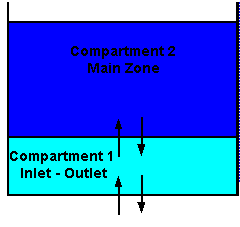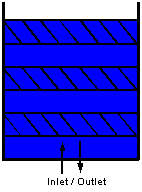About water quality mixing controls
InfoWorks WS Pro allows for the following reservoir mixing models:
- Fully Mixed: assumes one fully mixed compartment
- Two Compartment: assumes two fully mixed compartments: Inlet / Outlet Zone and Main Zone
- Three Compartment: assumes three fully mixed compartments: Inlet / Outlet Zone, Main Zone and Dead Zone. Exchange of water can occur between the Main Zone and Dead Zone.
- First-In First-Out: assumes no mixing in the reservoir. The first volume of water to enter the reservoir, is also the first to leave the reservoir.
- First-In Last-Out: assumes no mixing in the reservoir. The first volume of water to enter the reservoir is the last to leave the reservoir.
Fully Mixed
The Fully Mixed model is the default and assumes that the water entering the reservoir is instantaneously and fully mixed with water already stored in the reservoir.
Two Compartment
The Two Compartment model assumes two fully mixed zones: Inlet / Outlet Zone (Compartment 1) and a Main Zone (Compartment 2).
When the reservoir is being filled, water enters the inlet-outlet compartment. When this zone is full, any overflow is fed into the second compartment. On emptying, water is taken from the inlet-outlet compartment which is then replenished by water from the second compartment. As water is added and removed from only one zone, over time, water in the second compartment is likely to remain in the reservoir for longer and therefore have more time to undergo any chemical reactions.
The parameter required to model a Reservoir using the Two Compartment Mixing Model, is the Inlet-Outlet Compartment Volume Fraction (the fraction of the total reservoir volume which makes up the inlet / outlet compartment of the mixing model). If the Inlet-outlet volume fraction is set to zero, the model reverts to the fully mixed model.
Water Quality Mixing Model parameters are specified on the Reservoir Control page of the Reservoir property sheet.

Two Compartment Reservoir Mixing Model
Three Compartment
The Three Compartment model assumes three independent fully mixed zones: Inlet / Outlet Zone (Compartment 1), a Main Zone (Compartment 2) and a Dead Zone (Compartment 3).
Water enters and exits the reservoir at the Inlet / Outlet zone. The order of filling of zones is:
- Inlet / Outlet Zone
- Dead Zone
- Main Zone
On filling, water enters the inlet-outlet compartment with any overflow first filling the third compartment or dead zone. Once this is full, any overflow from the inlet-outlet compartment moves directly to the second or main compartment. While there is water in the main compartment and dead zone, in order that the dead zone is not entirely isolated, an exchange rate is provided to allow exchange between these two compartments. On emptying, water first leaves the inlet-outlet zone and this is first replenished by water from the main compartment. Once the main compartment is empty, water is then taken from the dead zone and finally from the input-output compartment.
The parameters required to model a Reservoir using the Three Compartment Mixing Model are:
- Inlet-Outlet Compartment Volume Fraction: the fraction of the total reservoir volume which makes up the Inlet / Outlet Zone of the mixing model
- Dead-Zone Compartment Volume Fraction: the fraction of the total reservoir volume which makes up the Dead Zone of the mixing model
- Dead-Main Exchange Rate: rate at which water is exchanged between the Dead Zone and the Main Zone
If the dead zone volume fraction is set to zero, the model reverts to the two compartment model. If the inlet-outlet volume fraction is set to zero, the result is a variation of the two-compartment model with the dead zone as the second compartment but now with an additional exchange rate between the two compartments.
Water Quality Mixing Model parameters are specified on the Reservoir Control Page of the Reservoir Property Sheet.

Three Compartment Reservoir Mixing Model
First-In First-Out
The First-In First- Out model assumes no mixing in the reservoir. Water is modelled as discrete packages or plugs. The plugs leave the reservoir in the same order in which they enter the reservoir.
Each plug of water entering is added in sequence retaining its volume and undergoing chemical reactions independently of other plugs.
This model may be suitable for reservoirs with inlet and outlet located at opposite ends of the reservoir and where mixing is not significant.

First-In First-Out Reservoir Mixing Model
First-In Last-Out
The First-In Last-Out model assumes no mixing in the reservoir. Water is modelled as discrete packages or plugs. The plugs leave the reservoir in reverse order of entering the reservoir.
As water enters the reservoir it is "stacked up" in a sequence of plugs and on changing to outflow, the first water to leave is from the last plug added. Each plug of water undergoes chemical reactions independently of other plugs.
This model may be suitable for reservoirs with only one inlet/outlet.

Last-In First-Out Reservoir Mixing Model
